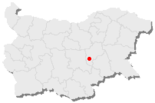Karanowo (Sliven Oblast)
| Karanowo (Караново) | |||
|
|||
| Basic data | |||
|---|---|---|---|
| State : |
|
||
| Oblast : | Sliven | ||
| Residents : | 943 (01/01/2007) | ||
| Coordinates : | 42 ° 31 ' N , 25 ° 55' E | ||
| Height : | 200 - 299 m | ||
| Postal code : | 8934 | ||
| Telephone code : | (+359) 04522 | ||
| License plate : | CH | ||
| administration | |||
| Mayor : | Denjo Denew | ||
Karanowo ( bulg . Караново ) is a village in southeastern Bulgaria , in Sliven Oblast , in the municipality of Nova Sagora .
There is a place of the same name Karanowo in the Burgas Oblast .
geography
The village of Karanowo is located in the northern part of the Upper Thracian Plain in close proximity to the southern foothills of the Sredna Gora Mountains . Karanowo is located 10 km west of the city of Nowa Sagora , 25 km east of Stara Sagora and 40 km southwest of the district town of Sliven . The village is located 5 km north of the connecting road between Stara Sagora and Nowa Sagora, which is part of the Sofia-Plovdiv-Burgas connection.
In the vicinity are the places Nowa Sagora , Stara Sagora , Sliven , Kazanlak , Veliko Tarnovo .
The area has been inhabited since the Neolithic Age. The soils are fertile and the climate pleasant and with high rainfall.
The village's population consists of 75% Bulgarians and 25% Roma.
history
In the vicinity of the village is a Neolithic settlement hill (Karanowo settlement hill), which gave its name to the Karanowo culture of the same name .
Archaeological excavations on the Karanowo settlement mound revealed the settlement of prehistoric cultures in the 6th to 2nd millennium BC. With small interruptions in the history of the settlement. In the Bronze Age the settlement hill was abandoned and the focus of the settlement shifted to the open plain. Archaeological traces have also been found from the subsequent early Iron Age.
At the beginning of the Roman era, a large ancient settlement was built one kilometer south of the settlement hill. In the years 1912 to 1914, archaeologists discovered coins from the 3rd to 4th centuries AD. From 1976, field research was carried out on the Kranow settlement mound for six years. Four construction periods were identified, which stretched from the 1st century AD to the first half of the 4th century. The earliest coin finds date from 46 BC. Under the 4th reign of Emperor Claudius . Archaeologists assume that either a noble's villa rustica or a path station on the way from Ulpia Augusta Trajana (today Stara Sagora ) to Anchialo stood here. (Note: Anchialos is very close to today's Pomorie . The Battle of Anchialos took place here on August 20, 917 AD .)
In addition to coins, this period also includes a large number of votive tablets of the Thracian rider , which speaks for the existence of a large sanctuary for the Baga rider. (Note: Baga - Bulgarian бага - is a proto-Bulgarian title.) In 1982 a statue of the Thracian horseman was found, which reached 2/3 the natural size, which also speaks for the existence of a sanctuary. A monumental building with 13 rooms was also discovered. Two rooms rectangular rooms with the dimensions 7.30 × 6.80 are specially designed.
The second construction period extended from the 3rd to the 4th century and began with the fortification of the object against the invading Goths . The northern fortress wall with three rectangular towers was exposed. They were made of broken masonry, layers of stone and brick alternate and are connected with mortar and broken bricks.
The new Christian faith was the reason for the construction of a small three-aisled basilica , into which parts of the destroyed buildings were integrated. A revolt by the Goths who settled as colonists led to the destruction of the property.
In the third construction phase, residential and farm buildings were built in a row near the destroyed protective wall. They were built from hewn stones connected with clay and covered with roof tiles. a new, larger basilica was also built. this third settlement was destroyed by the Huns.
The fourth construction period was in the time of Emperor Justinian I (reign 527 to 565 AD). He tried hard to counter the barbarian incursions by renovating the old fortresses and building new fortresses. A new basilica with triple apses was built, but of poor quality. In the second half of the 4th century the Avars and Slavs destroyed the settlement. Only two centuries later did a medieval settlement emerge on these ruins.


